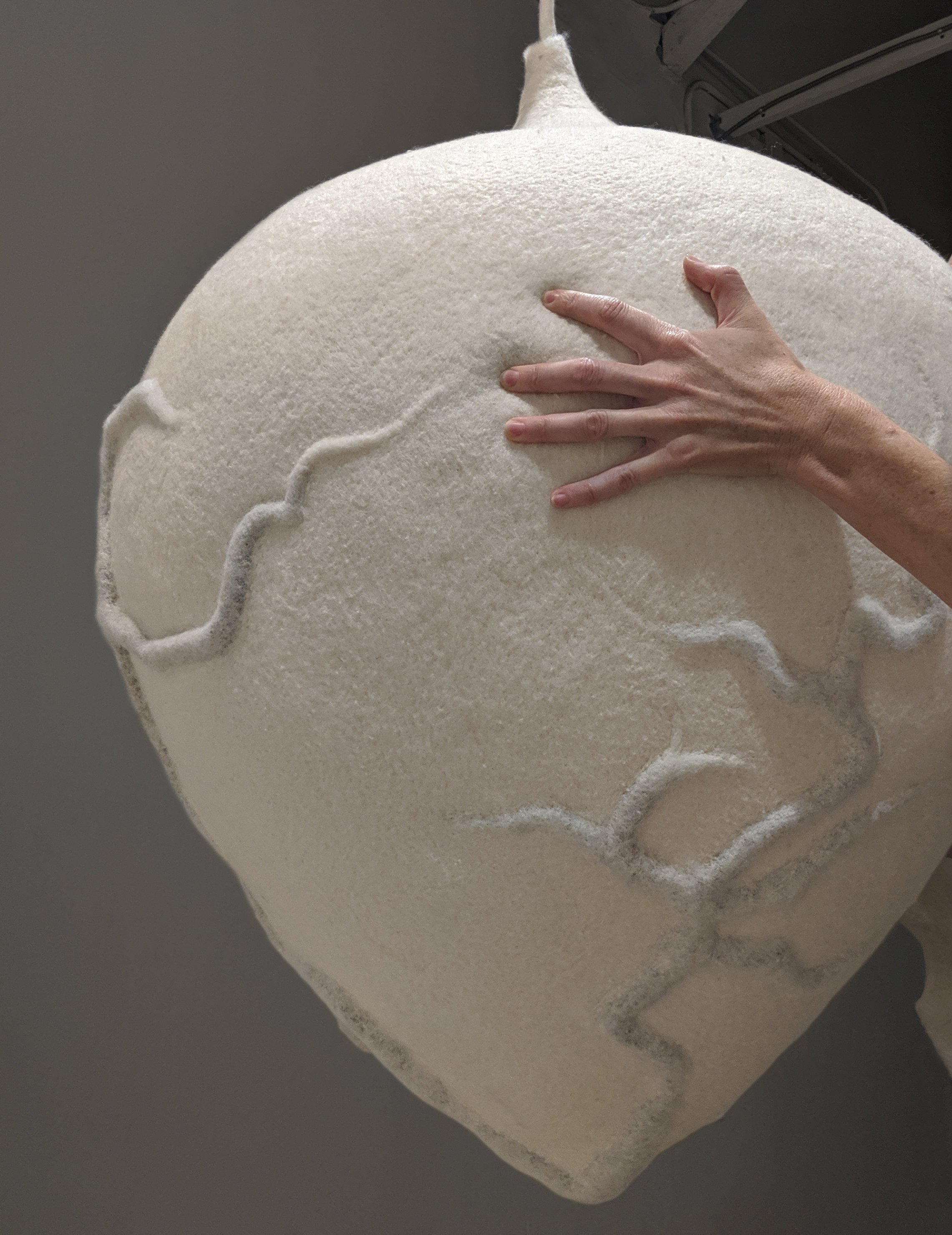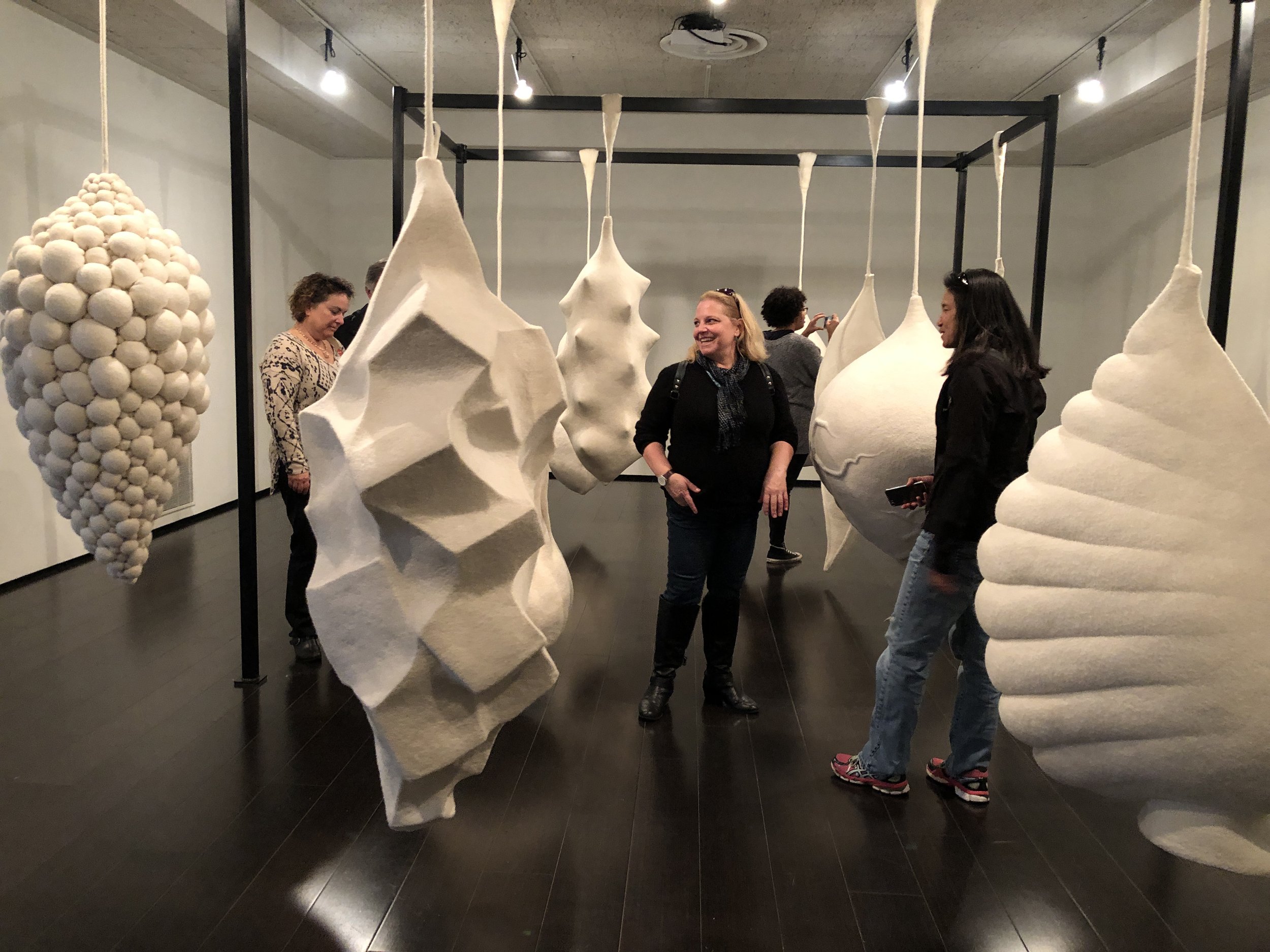Words About Sculpture About Touch [Why I Keep Re-Writing My Artist Statement]
Three of my ‘Hanging Pod’ touchable sculptures are headed to Georgia next week to be part of the ‘Please Touch the Art’ exhibit at Reeves House Gallery in Woodstock, from January 18 - March 24. If you can get there in person, you can see and touch these three beauties:
InTouch Hanging Pods: Quad Concavities, Boxy, and Orb Cluster
Every time I send art to exhibitions I also send a written document that is meant to contextualize the work, known as an ‘Artist Statement’. You may be familiar with these from the reading end OR the writing end, and you may love them or you may hate them. They are written for the layperson or the artworld elite or anyone in between. They can be sources of information, aggravation, densely stultifying artspeak or elegant turns of phrase. And, even if I’ve shown the work before, I find myself re-writing or heavily editing my Artist Statement EVERY SINGLE TIME.
(This is where the aggravation comes in for me. I toil far too long over the writing part.)
Why? Has the art changed?
Well, generally, no. It’s not that the art has changed. It’s that the context has changed, the times have changed, the cultural landscape has changed, most importantly I have changed.
You see, an Artist Statement is more of a living document, not settled history. It’s an attempt to address the ideas encapsulated in a physical object… but the experience of that object is not fixed, nor static.
When I’m getting ready to send out the objects I have created into the world again, along with some writing intended to, you know, simply encapsulate who I am as an artist and why I created the work and what it means (briefly, of course), I find myself re-reading my previous statements and realizing that they don’t quite capture it. Or at least, not from my current vantage point.
The Artist Statement is a moving target. I am a visual artist— I create objects to experience with the eyes, the body, the hands. Trying to lock onto that with words sometimes feels like trying to shoot an arrow at a far-off bullseye amid intermittent winds. And I keep twanging my fingers on the bowstring. I aim for the elegant turn of phrase that also provides information, but it takes a lot of tweaking to get close to there.
And I am very aware that the objects and ideas I put out into the world may be interpreted quite differently by different people at different times. But it feels like an act of good faith to keep working to get closer and closer to my target every time. So I do my best to choose my words with care and truth.
For this upcoming exhibition the topic is specifically about art you can touch. This time around in my re-write I found myself focusing on the sense of vulnerability of the body when it comes to touch. My thoughts are heavy of late, dwelling on the damage, insult, and danger to these vessels we inhabit. But I think hope always comes through as well. Below is the latest iteration of my official Artist Statement, illustrated with images of my touchable sculpture. I invite you to read it and let me know what you think:
————————————————————
Artist Statement: Please Touch The Art
Inviting visitors to touch the art is a radical act, so often forbidden due to its danger to the artwork or the visitor. But it also opens the possibility for casual moments of shared humanity: the experiences of wonder, curiosity, connection, or vulnerability. My touchable white felted wool ‘Hanging Pod’ sculptures are roughly human-sized, suggestive of recognizable organic shapes, yet also mysterious. Their tactile qualities of softness, firmness, pliability, and solidity can be explored by running one’s hands over their surfaces, squeezing, and hugging the sculptures.
View of the artist’s hand pressing against the pliable surface of InTouch Hanging Pod ‘Veiny Bulb.’ Photo by Stephanie Metz
To create these sculptures I needle-felted wool over pliable armatures: using specialized sharp, notched needles I tangled and embedded wool fibers to cover three-dimensional patterned shapes I made from stitched industrial felt with a core of fiberfill, or else over polystyrene blocks. My practice borrows from the realms of craft, design, and industry, yet its appearance is not crafty, functional, or industrial. My relationship to wool as a sculptural medium is not invested in traditional concerns about history or process-- I respond to it as a highly plastic and intrinsically responsive and visceral material with limitless potential for manipulation.
Close-up view of Hanging Pod ‘Quad Concavities’ revealing its surface texture of felted wool. Photo by Stephanie Metz.
By design the Hanging Pods are both specific and open-ended, familiar but unknown in their material and their forms. Both aspects seem to prompt a desire to touch-- and indulging that impulse can be highly satisfying. I use the word “wonder” because it refers to both a question and its response: curiosity as well as the feeling that comes from encountering the unexpected.
A visitor hugging hanging pod ‘Orb Cluster’ at the de Saisset Museum, Santa Clara, California. Photo by Maryana Petrenko.
Using one’s own fingertips to glean information about the world is a core part of the human experience. A personal ‘knowing’ through one of our most primal senses is a moving and complicated occurrence, and yet we lack a descriptive language about the varied qualities of touching.
Touch is most often related to the human body, and the Hanging Pods reference that loaded subject indirectly. In these encounters the Hanging Pods are passive recipients of touch, the vulnerable parties in the interaction. Touching an impersonal stand-in is both discomfiting and satisfying. Handling such objects may trigger a visitor to think about their own body, and the handling and objectification of others’. To be vulnerable is to be both brave and at risk-- and to recognize vulnerability in others. The performative and voyeuristic aspect of a shared public experience of touch forges a sense of communal trust, a connection to the others sharing that activity.
Visitor among Hanging Pods at the de Saisset Museum in Santa Clara. Photo by Mercer Hanau.
The alluring and tactile nature of my artform, the unusual offering of radically hands-on experiences, and the intellectual and physical gulf between the familiar and the alien opens up the possibility for engagement. Engagement, like making art and viewing artworks, requires attention and presence in the moment-- conditions for creating connections and experiencing wonder.
Touching hanging pod 'Planar’. Phot by Mercer Hanau.
————————————————————
So, dear reader, you’re as up-to-date as I am on my current thinking about this touchable sculpture. I would be pleased to know your response, your questions, your feedback. Because the other aggravating thing about Artist Statements (besides the mind-boggling labor of forcing words out) is that they’re so very one-sided. Writing them feels like shouting into the void because they’re so often placed in a binder at a gallery but not part of a conversation. Putting so much thought, effort, and time into writing about my own work IS, no doubt, good for my processing of what I’m doing and my growth as a person and an artist. But I’d also love to hear from you.







